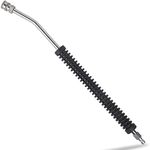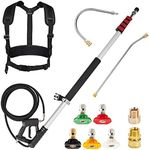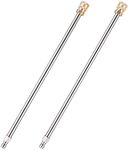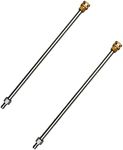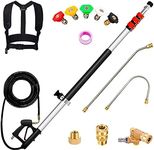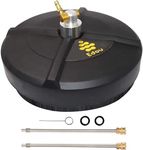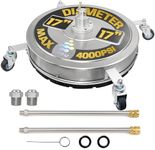Buying Guide for the Best Telescoping Pressure Washer Wand
Choosing a telescoping pressure washer wand can make cleaning high or hard-to-reach places much easier and safer, as it allows you to stay on the ground while reaching upper stories, gutters, or tall vehicles. The right wand for you depends on your cleaning needs, the height you need to reach, and how comfortable you want the experience to be. Understanding the key features will help you select a wand that is both effective and easy to use.Length (Reach)The length of a telescoping pressure washer wand determines how high or far you can reach without using a ladder. Wands typically range from about 12 to 24 feet when fully extended. Shorter wands (up to 12 feet) are easier to handle and are suitable for cleaning vehicles, single-story homes, or decks. Medium-length wands (12-18 feet) are good for reaching gutters or the second story of a house. Longer wands (18-24 feet) are best for tall buildings or very high areas, but they can be heavier and harder to control. To pick the right length, consider the highest point you need to clean and whether you want to prioritize reach or ease of handling.
MaterialThe material of the wand affects its weight, durability, and ease of use. Common materials include aluminum, fiberglass, and sometimes stainless steel. Aluminum wands are lightweight and resistant to rust, making them easy to maneuver for longer periods. Fiberglass wands are also light and offer good strength, but may be slightly more flexible. Stainless steel wands are very durable but can be heavier. If you plan to use the wand for extended periods or need to reach high places, a lighter material will reduce fatigue. For heavy-duty or frequent use, durability may be more important.
Maximum Pressure Rating (PSI)The maximum pressure rating, measured in PSI (pounds per square inch), tells you how much water pressure the wand can safely handle. Most wands are rated between 3000 and 4000 PSI. If your pressure washer produces high pressure, make sure the wand can handle it to avoid damage or safety risks. For light cleaning tasks, a lower PSI rating is sufficient, but for tough jobs like stripping paint or cleaning concrete, a higher PSI rating is better. Always match the wand’s rating to your pressure washer’s output.
WeightThe weight of the wand is important because a heavier wand can be tiring to use, especially when fully extended. Lighter wands are easier to control and less likely to cause fatigue, but may be less sturdy. Heavier wands can be more stable but harder to hold for long periods. If you need to use the wand for long cleaning sessions or at full extension, a lighter model will be more comfortable.
Nozzle CompatibilityNozzle compatibility refers to the types of spray tips or attachments the wand can accept. Some wands come with quick-connect fittings, making it easy to switch between different nozzles for various cleaning tasks. Others may require specific adapters. If you want flexibility in your cleaning, look for a wand that works with a wide range of nozzles. Make sure it matches the nozzles you already have or plan to use.
Locking MechanismThe locking mechanism is what keeps the wand extended at your chosen length. Some wands use twist locks, while others use lever or button locks. A good locking mechanism is important for safety and ease of use, as it prevents the wand from collapsing or slipping during use. If you need to adjust the length frequently or want extra security, look for a wand with a reliable and easy-to-use locking system.
Hose Connection TypeThe hose connection type determines how the wand attaches to your pressure washer hose. Common types include threaded connections and quick-connect fittings. Quick-connect fittings are faster and easier to use, while threaded connections may provide a more secure fit. Make sure the wand’s connection type matches your pressure washer hose, or check if adapters are available.
